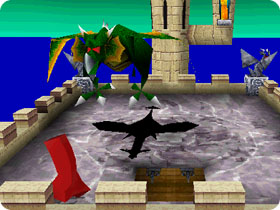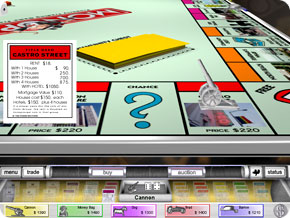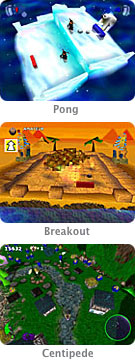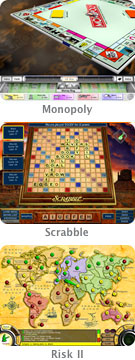Atari Arcade Classics

Breakout. Whack that dragon!
- Site: Arcade Classics
- Publisher: MacSoft Games
- Developer: Atari
- Genre: Action
Note: Arcade Classics is no longer available from MacSoft, however you may still be able to find it at your local retail store.

The Arcade Classics package features three remakes of titles that many gamers fondly remember from the early days: Pong, Breakout and Centipede. In the first, you and your opponent control thin lines (known as “bats”) that you move up and down either side of the screen and use to hit a ball. Every time the ball gets past your opponent, you score one point. This version takes you through a variety of environments with different challenges as you try to win every match.
In Breakout, you use your bat to bounce the ball against a wall and eliminate all the bricks before moving on to the next level. This updated version takes that basic gameplay and enhances it with a story. Now the bat can stand on one end and look around with a pair of expressive eyes, and the game has turned into a tale about a hero named Bouncer, who must save his girlfriend, Daisy, from the clutches of the evil Batnix. Unfortunately, Batnix has thrown Bouncer in a dungeon at the start of the game, and you must break out of it before you can hope to rescue Daisy.
Centipede was originally a basic 2D shoot-‘em-up in which you fired at a centipede as it marched through a mushroom field while spiders, scorpions, and other creepy crawlies attacked you from all sides. This remake features two modes: story, which tells the tale of Wally’s defense of the “wee people” against the evil Queen Centipede’s attacks; and arcade, which takes the originally gameplay and makes it 3D.
All three games also feature multi-player action over the Internet or a LAN, with Breakout and Pong adding the option to take on other gamers on the same computer.




